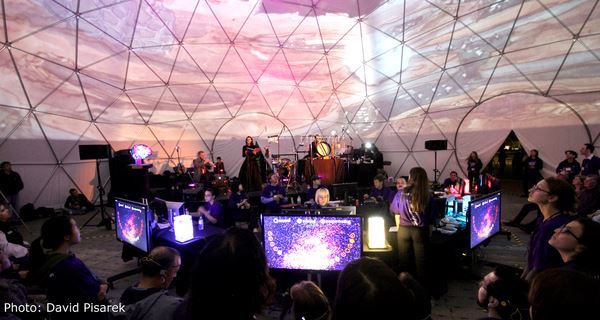Neuroscience 2.0: Taking the lab to the people by gathering collective EEG brain data
.
‘Wearable for the mind’ launches new era of brain research (Electronic Products & Technology):
“Neuroscientists in Toronto have shown that crowdsourcing brain research to hundreds of participants in a short period of time could be a new frontier in neuroscience and lead to new insights about the brain…
Dr. Natasha Kovacevic of Baycrest Health Sciences’ Rotman Research Institute is the lead author of a scientific paper on the crowdsourcing experiment…Festival-goers wore the Muse headband and participated in a brief collective neurofeedback experience in groups of 20 inside a 60-foot geodesic dome. A total of 523 adults (209 males, 314 females), ranging in age from 18 to 89, contributed their EEG brain data for the study. The participants played a collective neurofeedback game where they were required to manipulate their mental states of relaxation and concentration. The neurofeedback training lasted 6.5 minutes, which is much shorter than typical neurofeedback training experiments. The group’s collective EEG signals were used to control lighting and imagery inside the exhibit.
“What we’ve done is taken the lab to the public,” said Dr. Kovacevic. “We collaborated with multi-media artists, made this experiment incredibly engaging, attracted highly motivated subjects which is not easy to do in the traditional lab setting, and collected useful scientific data from their experience.”
Study: My Virtual Dream: Collective Neurofeedback in an Immersive Art Environment (PLOS ONE)
- Abstract: While human brains are specialized for complex and variable real world tasks, most neuroscience studies reduce environmental complexity, which limits the range of behaviours that can be explored. Motivated to overcome this limitation, we conducted a large-scale experiment with electroencephalography (EEG) based brain-computer interface (BCI) technology as part of an immersive multi-media science-art installation. Data from 523 participants were collected in a single night. The exploratory experiment was designed as a collective computer game where players manipulated mental states of relaxation and concentration with neurofeedback targeting modulation of relative spectral power in alpha and beta frequency ranges. Besides validating robust time-of-night effects, gender differences and distinct spectral power patterns for the two mental states, our results also show differences in neurofeedback learning outcome. The unusually large sample size allowed us to detect unprecedented speed of learning changes in the power spectrum (~ 1 min). Moreover, we found that participants’ baseline brain activity predicted subsequent neurofeedback beta training, indicating state-dependent learning. Besides revealing these training effects, which are relevant for BCI applications, our results validate a novel platform engaging art and science and fostering the understanding of brains under natural conditions.
To learn more:



